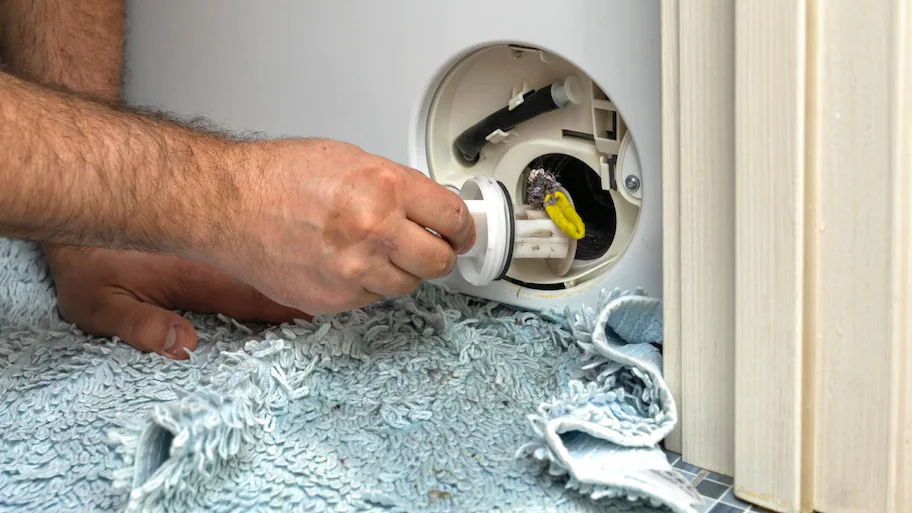Is your washing machine not draining or spinning properly? Do you notice foul odors or excessive suds coming from the machine? If so, you likely have a clogged drain hose or pump that needs unclogging. Clogs in the washing machine drain system are common, often caused by loose change, socks, lint and other debris. Unclogging a blocked drain is an easy DIY project that can save you money on expensive appliance repairs. This step-by-step guide will teach you how to locate and clear drain clogs to get your washer functioning optimally again.
Why Unclogging the Drain is Important
Allowing drain clogs to persist can lead to a number of problems, including:
- Drainage Issues: Clogged drains prevent wastewater from properly evacuating the wash tub during cycles. This leaves standing water in the tub that won’t drain.
- Water Buildup: With nowhere to go, water will back up in the tub or leak from the machine. This can cause an overflow, water damage and mold concerns.
- Excess Detergent Residue: Detergent and soils remain stuck in the tub and on laundry, instead of flushing down the drain. This leaves crunchy, sudsy residue on clothes.
- Foul Odors: Soap scum, mildew, mold and bacteria breed in the stagnant water and spread foul odors.
- Drain Pump Damage: Debris can jam the drain pump impeller, leading to premature pump failure.
Regularly unclogging the drain prevents these problems and maintains optimal washer performance.
Locating the Washing Machine Filter
Washing machine filters are commonly found in one of two locations, depending on whether you have a top loader or front loader model:
- Top Load Washers: In most top load machines, the filter is located in the center of the agitator tube. Removing the agitator cap provides access to extract the filter for cleaning.
- Front Load Washers: Front load washers have filters behind a small drain dispenser drawer, usually on the bottom right. The drawer pulls out to access the filter.
Consult your owner’s manual to locate the filter if unsure. Front loaders should be cleaned every 3-6 months, top loaders every 6-12 months.
Draining the Pump Hose
Before removing the washing machine drain filter, the pump hose should be drained to avoid a mess. Follow these steps:
- Place a shallow pan or container wrapped with a towel under the filter housing to catch water.
- Unclip the drain hose from its holder. Remove the small plug on the hose end.
- Point the hose into the drain pan to empty water from the hose.
- When fully drained, replace the hose plug and re-clip the hose into place.
Removing the Drain Pump Filter
With the hose drained, you can now remove the filter:
- Turn the filter counterclockwise to loosen and unthread it completely.
- Pull the filter straight out once detached. Place it on the towel or in the drain pan.
Wear rubber gloves and have towels ready, as residual water may spill out.
Cleaning the Filter
Inspect the washing machine drain filter for any debris:
- Remove lint, hair, coins, socks and other large debris from the filter by hand.
- Rinse any remaining residue off the filter with hot running water.
- Use a soft brush to dislodge stuck-on debris if needed.
Avoid using detergents or bleach to clean the filter, which could damage components.
Replacing the Drain Pump Filter
After a thorough cleaning, replace the washing machine drain filter:
- Reinsert the filter into the housing port and press firmly.
- Twist clockwise until the filter handle is vertical and locked into place.
Double check that the filter is properly realigned and threaded before moving on.
Replacing the Dispenser Drawer
For front load washers, replace the drain dispenser drawer last:
- Line up both sides of the drawer in the rails simultaneously.
- Push in the drawer and make sure it clicks into place properly.
- Open and close the drawer completely to confirm it slides smoothly.
Leave the drawer closed and replace any laundry or other items around the machine.
Testing for Successful Unclogging
Once fully reassembled, test your DIY drain cleaning:
- Run a short cycle with no laundry, or with just 1-2 small items.
- Make sure the washer tub drains fully without overflowing.
- Confirm that foul odors were eliminated.
If any issues persist, double check that the filter is aligned correctly. You may need to re-clean the filter or inspect the drain hose further to ensure any debris clogging the system was fully cleared. With proper filter maintenance, your washing machine can keep running like new.

